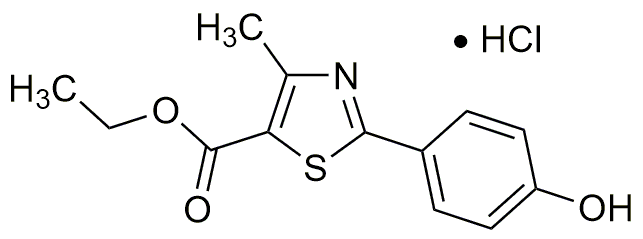Ethyl 2-(4-hydroxyphenyl)-4-methylthiazole-5-carboxylate hydrochloride is widely utilized in research focused on:
- Pharmaceutical Development: This compound is explored for its potential as a therapeutic agent, particularly in the treatment of various diseases due to its unique chemical structure that may interact effectively with biological targets.
- Antioxidant Research: Its antioxidant properties make it a candidate for studies aimed at reducing oxidative stress in cells, which is relevant in fields like aging and chronic disease research.
- Material Science: The compound can be used in the development of new materials, particularly those requiring specific chemical stability or reactivity, enhancing the performance of coatings or polymers.
- Agricultural Chemistry: It is being investigated for use in agrochemicals, potentially serving as a plant growth regulator or a component in pest control formulations, benefiting crop yield and sustainability.
- Biochemical Assays: Researchers utilize this compound in various assays to study enzyme activity or receptor binding, providing insights into metabolic pathways and drug interactions.
General Information
Properties
Safety and Regulations
Applications
Ethyl 2-(4-hydroxyphenyl)-4-methylthiazole-5-carboxylate hydrochloride is widely utilized in research focused on:
- Pharmaceutical Development: This compound is explored for its potential as a therapeutic agent, particularly in the treatment of various diseases due to its unique chemical structure that may interact effectively with biological targets.
- Antioxidant Research: Its antioxidant properties make it a candidate for studies aimed at reducing oxidative stress in cells, which is relevant in fields like aging and chronic disease research.
- Material Science: The compound can be used in the development of new materials, particularly those requiring specific chemical stability or reactivity, enhancing the performance of coatings or polymers.
- Agricultural Chemistry: It is being investigated for use in agrochemicals, potentially serving as a plant growth regulator or a component in pest control formulations, benefiting crop yield and sustainability.
- Biochemical Assays: Researchers utilize this compound in various assays to study enzyme activity or receptor binding, providing insights into metabolic pathways and drug interactions.
Documents
Safety Data Sheets (SDS)
The SDS provides comprehensive safety information on handling, storage, and disposal of the product.
Product Specification (PS)
The PS provides a comprehensive breakdown of the product’s properties, including chemical composition, physical state, purity, and storage requirements. It also details acceptable quality ranges and the product's intended applications.
Certificates of Analysis (COA)
Search for Certificates of Analysis (COA) by entering the products Lot Number. Lot and Batch Numbers can be found on a product’s label following the words ‘Lot’ or ‘Batch’.
Numéro de catalogue
Numéro de lot/série
Certificates Of Origin (COO)
This COO confirms the country where the product was manufactured, and also details the materials and components used in it and whether it is derived from natural, synthetic, or other specific sources. This certificate may be required for customs, trade, and regulatory compliance.
Numéro de catalogue
Numéro de lot/série
Safety Data Sheets (SDS)
The SDS provides comprehensive safety information on handling, storage, and disposal of the product.
DownloadProduct Specification (PS)
The PS provides a comprehensive breakdown of the product’s properties, including chemical composition, physical state, purity, and storage requirements. It also details acceptable quality ranges and the product's intended applications.
DownloadCertificates of Analysis (COA)
Search for Certificates of Analysis (COA) by entering the products Lot Number. Lot and Batch Numbers can be found on a product’s label following the words ‘Lot’ or ‘Batch’.
Numéro de catalogue
Numéro de lot/série
Certificates Of Origin (COO)
This COO confirms the country where the product was manufactured, and also details the materials and components used in it and whether it is derived from natural, synthetic, or other specific sources. This certificate may be required for customs, trade, and regulatory compliance.

